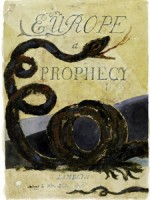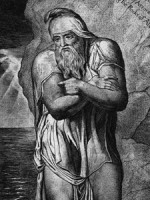Column Name
Title
The Morgan Library possesses the most distinguished collection of William Blake’s art and poetry manuscripts in the United States, but due to space constraints, it is rarely on view. Fortunately, now through January 3, more than 100 works from the collection are on exhibition in a show titled “William Blake’s World: A New Heaven Is Begun.” This is cause for celebration for everyone, but especially for musicians and all creative artists.
Body
William Blake (1757-1827) is regarded as one of the most powerful exemplars of the age of Romanticism—in both his poetry and his visual art. Blake observed the world in terms of opposites and extremes. His books Songs of Innocence and Experience and The Marriage of Heaven and Hell deal with these in word and image. Some illustrations from each of these are included in the exhibit. Blake scholars often stress the inextricable connection of text and image in his work; he considered the arts to be inseparable. Further, he has inspired many composers to write music based on his art. Legend has it, in fact, that he himself composed melodies.
Blake asserted that he copied the imagination rather than nature. In this regard, he resonates with other great Romantics. I am especially reminded of the German painter Caspar David Friedrich’s (1774-1840) famous statement: “Close your physical eye, and paint with your spiritual one.” Fascinatingly, however, Blake’s art does not in the least bear a resemblance to Friedrich’s; indeed, on the surface, the two seem almost polar opposites. Friedrich’s paintings look almost photographic, while Blake’s appear to come directly from his mind’s eye. One way to see this is as part of the Romantic sensibility: two such different results arising from spiritual kinship of thought processes.
It is unusual to see series of original Blake watercolors displayed in their entirety. At the Morgan Library, we have the opportunity to see two major series, the 21 drawings for the Book of Job (1805-10), and 12 for John Milton’s poems “L’Allegro” and “Il Penseroso,” executed about 1816-20.
For the sake of music, a close look at Blake’s unique interpretation of the Book of Job is rewarding. The first and last of Blake’s 21 illustrations can be seen as a parable for music’s power. Unlike the Old Testament book in which only Job’s faith is tested, Blake’s version examines his psychology. Blake’s interpretation of Job is distinctive. He insists that God punishes Job for his failure to love as a Christian should. In this artist’s view, Job’s blind faith is not sufficient; and in Blake’s universe it is the unseeing, unfree characters that consistently undergo tortures.
The first picture in the Job series shows the patriarch and his wife sitting peacefully, surrounded by 10 devout children, while their sheep doze before them. Peculiarly, musical instruments are hanging from the branches of a tree. All is well; everyone is happy and well fed, and they are all “God fearing.” But there is a problem. These are musicians who are not engaged; they are too passive. The musical instruments they should be playing to honor the Lord are out of reach. Since the book of Psalms tells us to “praise the Lord with stringed instruments and make a joyful noise unto the Lord,” they are neither fulfilling their duties nor their potential.
The final tableau, however, depicts Job and his family carrying out this injunction. In Job and His Family Restored to Prosperity, the entire energy has changed. Everybody stands, reaching upwards as Job plays a harp, his wife a lute, and the children blast trumpets and other instruments. They have taken the instruments down from the tree and are invigorated by active praise. Even the sheep look up, as if to acknowledge the music. Blake includes the text: “The Lord blessed the latter end of Job more than the beginning.”
In the 19 illustrations between first and last in this series, Blake depicts Job’s temptations, illnesses, and losses.
The other series of illustrations for Milton are also musical in nature. In fact, Mirth, from “L’Allegro,” could be a later visual counterpart to Handel’s setting, about 80 years earlier, c. 1740. There the composer “word paints” the text: “And laughter ho ho ho ho ho ho holding both his sides.” Not only is the center figure of Blake’s Mirth echoed in numerous smaller merry dancing girls and boys, but one strange looking little guy literally holds both his sides. Even more resplendent is The Sun at His Eastern Gate, a nude, blond boy surrounded by flames and angels, his feet touching the top of a mountain. The antithesis, Melancholy, from “Il Penseroso,” is a static, clothed woman surrounded by other figures with their feet solidly on the ground. Clearly Blake envisions the opposite of freedom and imagination as too much groundedness and lack of joy.
Many other works intrigue and inspire with their deceptively simple-looking designs. Some of my favorites are frontispieces for Blake’s books Europe: A Prophecy and America: A Prophecy. In both of those, letters twirl around, dancing with images. The text, “Europe,” interacts with the picture of a huge dragon, its red tongue painting the sky like a torch. The “America” text is drawn inside clouds, while earthbound figures struggle in dark rain.
Few can remain unmoved by Blake’s powerful imagination. In his day, many considered this artist/poet who conversed and dined with prophets mad. Even today, he engenders strong feelings—love or hate. No one is lukewarm. In fact, William Blake is a cult figure for many.
Opposed to political oppression and racism, he was in favor of women’s rights during an early era. Some argue whether his mysticism was a disguise for his political beliefs, or if his spiritual powers enabled him to see through and beyond politics. Whatever one may think, for those of us in the arts, he is especially relevant. To Blake, “poetry, painting, and music are man’s three ways of conversing with paradise.”
“William Blake’s World: A New Heaven Is Begun” runs through January 3 at the Morgan Library and Museum, 225 Madison Avenue at 36th Street. The museum is open Tuesday through Thursday from 10:30 a.m. to 5 p.m.; Friday from 10:30 a.m. to 9 p.m.; Saturday from 10 a.m. to 6 p.m.; Sunday from 11 a.m. to 6 p.m.; it is closed on Monday.







